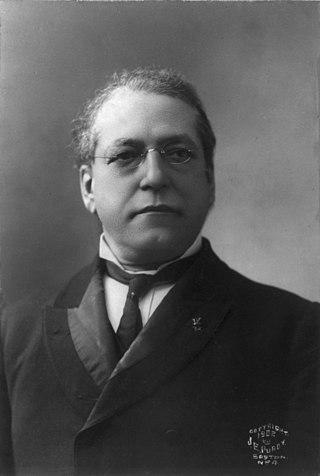A trade union or labor union, often simply referred to as a union, is an organization of workers whose purpose is to maintain or improve the conditions of their employment, such as attaining better wages and benefits, improving working conditions, improving safety standards, establishing complaint procedures, developing rules governing status of employees and protecting and increasing the bargaining power of workers.

The 1830s was a decade of the Gregorian calendar that began on January 1, 1830, and ended on December 31, 1839.
The General Trades' Union was formed in New York City in 1833 with the purpose of uniting all of the trade societies of New York. The goal of this central union was to better coordinate the various trade unions in the New York City area, to provide assistance during conflicts with employers, and to maintain a fund for striking laborers. The GTU formed the National Trades Union, the first attempt at a nationwide union movement. The GTU of New York organised one the first strikes in the United States and initiated the system now known as collective bargaining.

The Panic of 1837 was a financial crisis in the United States that began a major depression which lasted until the mid-1840s. Profits, prices, and wages dropped, westward expansion was stalled, unemployment rose, and pessimism abounded.
Industrial unionism is a trade union organising method through which all workers in the same industry are organized into the same union, regardless of skill or trade, thus giving workers in one industry, or in all industries, more leverage in bargaining and in strike situations. De Leon believed that militarized Industrial unions would be the vehicle of class struggle.

Samuel Gompers was a British-born American cigar maker, labor union leader and a key figure in American labor history. Gompers founded the American Federation of Labor (AFL) and served as the organization's president from 1886 to 1894, and from 1895 until his death in 1924. He promoted harmony among the different craft unions that comprised the AFL, trying to minimize jurisdictional battles. He promoted thorough organization and collective bargaining in order to secure shorter hours and higher wages, which he considered the essential first steps to emancipating labor.

The American Federation of Labor was a national federation of labor unions in the United States that continues today as the AFL-CIO. It was founded in Columbus, Ohio, in 1886 by an alliance of craft unions eager to provide mutual support and disappointed in the Knights of Labor. Samuel Gompers was elected the full-time president at its founding convention and was re-elected every year except one until his death in 1924. He became the major spokesperson for the union movement.

The Australian Council of Trade Unions (ACTU), originally the Australasian Council of Trade Unions, is the largest peak body representing workers in Australia. It is a national trade union centre of 46 affiliated unions and eight trades and labour councils. The ACTU is a member of the International Trade Union Confederation.

The Seattle General Strike was a five-day general work stoppage by 65,000 workers in the city of Seattle, Washington from February 6 to 11, 1919. The goal was to support shipyard workers in several unions who were locked out of their jobs when they tried to strike for higher wages. Most other local unions joined the walk-out, including members of the American Federation of Labor (AFL) and the Industrial Workers of the World (IWW). The national offices of the AFL unions were opposed to the shutdown. Local, state and federal government officials, the press, and much of the public viewed the strike as a radical attempt to subvert American institutions.
UNI Global Union, formally Union Network International (UNI), is a Global Union Federation for the skills and services sectors, uniting national and regional trade unions. It has affiliated unions in 150 countries representing 20 million workers. The Global headquarters is in Nyon, Switzerland. UNI Global Union ratified over 50 Global Framework Agreements with multinational corporations including ABN AMRO, Carrefour, H&M, DHL, Telefonica, BNP Orange and Banco de Brazil, Inditex Group, Kimberly Clark among others as of 2021.

The Federation of Organized Trades and Labor Unions of the United States and Canada (FOTLU) was a federation of labor unions created on November 15, 1881, at Turner Hall in Pittsburgh. It changed its name to the American Federation of Labor (AFL) on December 8, 1886.

The Ceramic and Allied Trades Union (CATU) was a trade union representing pottery workers in the United Kingdom.
The eight-hour day movement was a social movement to regulate the length of a working day, preventing excesses and abuses of working time.
The following is a timeline of labor history, organizing & conflicts, from the early 1600s to present.

Ely Moore was an American newspaperman and labor leader who served two terms as a Jacksonian U.S. Representative from New York from 1835 to 1839.

The Workers' Unity League (WUL) was established in January 1930 as a militant industrial union labour central closely related to the Communist Party of Canada on the instructions of the Communist International.

The American Labor Union (ALU) was a radical labor organization launched as the Western Labor Union (WLU) in 1898. The organization was established by the Western Federation of Miners (WFM) in an effort to build a federation of trade unions in the aftermath of the failed Leadville Miners' Strike of 1896. The group changed its name from WLU to the more familiar ALU moniker in 1902 at its fifth annual convention. The group had a peak membership of about 43,000 — of which 27,000 were members of the WFM. The ALU was a precursor to the Industrial Workers of the World (IWW), established in 1905, which effectively terminated it.
The Grand National Consolidated Trades Union of 1834 was an early attempt to form a national union confederation in the United Kingdom.

The Irish Trades Union Congress (ITUC) was a union federation covering the island of Ireland.
The Mechanics' Union of Trade Associations was an American trade union founded in Philadelphia, Pennsylvania, in 1827.











